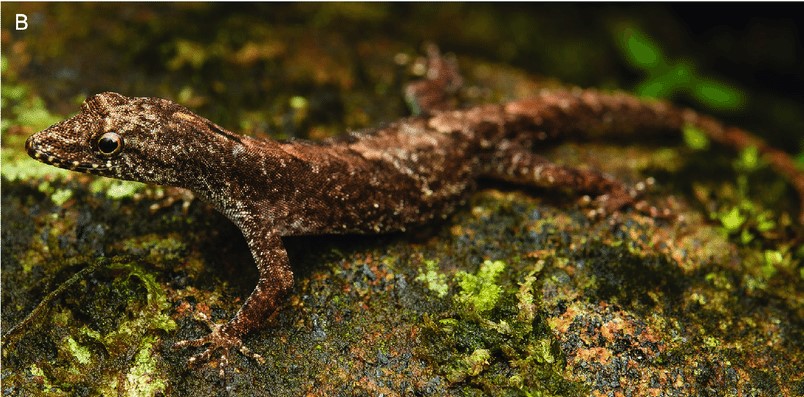- A new species of day gecko, Cnemaspis godagedarai, has been described in Sri Lanka, bringing the island’s number of endemic geckos in the genus Cnemaspis to 25.
- The new gecko, named after a national hero in the fight against British colonial rule, shares its microhabitat with seven other species of endemic reptiles, making the conservation of their habitat critical to their survival.
- With more than 80 percent of Sri Lanka’s species being endemic to the island, and a majority of them restricted to the wet zone, the country needs special species conservation mechanisms, researchers say.
From the eastern fringe of Sri Lanka’s only rainforest, Sinharaja, scientists have described a new species of day gecko, the latest to join an ever-expanding list of remarkable reptiles found only on this Indian Ocean island.
The Godagedara’s day gecko (Cnemaspis godagedarai) is described in a paper published in the June edition of the journal Amphibian & Reptile Conservation, which places it in the unique microhabitat of Ensalwatte, in the southern district of Matara.
“The gecko was discovered in a mountainous area that lies between 700 and 800 meters [2,300 and 2,600 feet] above sea level and isolated from the rest of the forest canopy by streams,” herpetofaunal ecologist and lead author Suranjan Karunarathna told Mongabay. “This type of isolation is very special and the endemic species like this day gecko will be ‘point endemic,’” or restricted to a very small area.
“The highly restricted habitat shows that the species is susceptible to both localized and widespread threats. It is critically endangered due to having a very small geo-referenced location of about 500 miles [800 kilometers] radius,” Karunarathna said. The study says the species should be considered critically endangered under the IUCN Red List criteria.
The researchers named the new gecko after Godagedara Rate Adikaram, a national hero who fought in the uprising against the British colonial government from 1817 to 1818.
C. godagedarai becomes the 25th distinct species of Cnemaspis day gecko found only in Sri Lanka. According to the researchers,it closely resembles C. gemunu, C. phillipsi and C. scalpensis, though their localities are distinct within the Peak Wilderness area, a UNESCO World Heritage Site.

The addition of this new endemic gecko species to the Sri Lankan reptile list, so soon after the description earlier this year of yet another day gecko, further highlights the island’s status as a key center of reptilian diversity, the researchers say.
Importantly, the study shows that Sri Lanka’s Cnemaspis diversity is limited to the southwestern lowlands and the central massif, highlighting these regions as key targets for conservation.
“As a first step to prevent extinction of the critically endangered species, the preservation of the species’ microhabitat should be treated as a top priority,” Karunarathna said.
“Ensalwatte area needs specific ecosystem management,” he added of the area where C. godagedarai occurs. “Local communities encroach [into the] forest land for cultivation and for fuelwood. There is illicit gem [mining] as well. Well-managed, sustainable ecotourism initiatives can ensure better livelihoods and make people aware of the need to protect the environment that sustains them.”
Equally important is the demarcation of boundaries, Karunarathna said. He called for the privately owned forest patches in the area to be acquired and managed by the Department of Forests, and for the establishment of a forest department office in the Ensalwatte region.
The study also indicates that the geographically isolated mountain habitats where much of the genus are found, among granite caves and rock outcrops, and favorable environmental conditions make it likely that there could be more than 50 distinct Cnemaspis gecko species on the island.
Species in Sri Lanka exhibit high endemism, with more than 80 percent of them found nowhere else on Earth, and the majority in the island’s wet zone alone. All 25 known Cnemaspis species in Sri Lanka are endemic.

Conservation needs
These unique habitats that have given rise to high biodiversity are threatened by human disturbances, such as encroachment for tea plantations and other crops, as well as human settlements, the paper says. Besides day geckos, a rich variety of other reptiles also occur only in the Sinharaja Forest Reserve, says Karunarathna.
These include the Ceylon black-band whistling lizard (Calotes desilvai), named after renowned and prolific herpetologist Anslem de Silva, a co-author of the new paper; Erdelen’s horned lizard (Ceratophora erdeleni); Karu’s horned lizard (Ceratophora karu); Rakwana day gecko (Cnemaspis pulchra); Sinharaja bent-toed gecko (Cyrtodactylus subsolanus); Eranga Viraj’s shieldtail (Rhinophis erangaviraji); and the Morningside tree frog (Taruga fastigo) — all of them endemic and critically endangered.
The researchers have called for extensive faunal surveys, along with detailed examination of physical features and genetic analyses to discover the actual status of Cnemaspis diversity in Sri Lanka.
“Such studies should focus on isolated hills, smaller forests rock outcrops, and granite caves including underground tunnel systems,” the paper says.
Citation:
De Silva, A., Bauer, A. M., Botejue, M., & Karunarathna, S. (2019). A new species of endemic day gecko (Reptilia: Gekkonidae: Cnemaspis) from a wet zone forest in the second peneplain of Southern Sri Lanka. Amphibian & Reptile Conservation, 13(1), e177, 198-208.
Banner image of Cnemaspis godagedarai, a newly described species of day gecko endemic to Sri Lanka, by Chen Lee.
